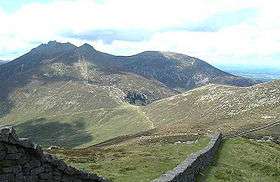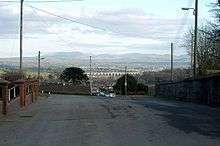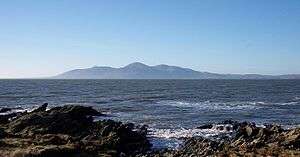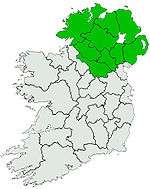Mourne Mountains
| Mourne Mountains | |
|---|---|
| Na Beanna Boirche | |
|
View of the Mournes from St John's Point, County Down | |
| Highest point | |
| Peak | Slieve Donard |
| Elevation | 850 m (2,790 ft) |
| Geography | |
| Sovereign state | United Kingdom |
| Constituent country | Northern Ireland |
| Counties | County Down |
| Geology | |
| Type of rock | Granite |
The Mourne Mountains (pronounced /ˈmɔərn/ MOHRN; Irish: na Beanna Boirche), also called the Mournes or Mountains of Mourne, are a granite mountain range in County Down in the south-east of Northern Ireland. It includes the highest mountains in Northern Ireland and the province of Ulster. The highest of these is Slieve Donard at 850 m (2,790 ft). The Mournes is an Area of Outstanding Natural Beauty and has been proposed as the first national park in Northern Ireland. The area is partly owned by the National Trust and sees a large number of visitors every year. The name Mourne (historically spelt Morne) is derived from the name of a Gaelic clann or sept called the Múghdhorna.[1][2]
The mountains
The Mournes are visited by many tourists, hillwalkers, cyclists and rock climbers. Following a fundraising drive in 1993, the National Trust purchased nearly 5.3 km2 (1,300 acres) of land in the Mournes. This included a part of Slieve Donard and nearby Slieve Commedagh, at 767 m (2,516 ft) the second-highest mountain in the area.

The Mourne Wall is among the more famous features in the Mournes. It is a 35 km (22-mile) dry-stone wall that crosses fifteen summits, constructed to define the boundaries of the 36 km2 (8,900-acre) area of land purchased by the Belfast Water Commissioners in the late 1800s. This followed a number of Acts of Parliament allowing the sale, and the establishment of a water supply from the Mournes to the growing industrial city of Belfast. Construction of the Mourne Wall was started in 1904 and was completed in 1922.
Some of the mountains have names beginning "Slieve", from the Irish word sliabh, meaning "mountain". Examples are Slieve Donard, Slieve Lamagan and Slieve Muck. There are also a number of curious names: Pigeon Rock; Buzzard's Roost; Brandy Pad; the Cock and Hen; Percy Bysshe; the Devil's Coach Road; and Pollaphuca, which means "hole of the fairies or sprites".
The Mournes are very popular as a destination for many Duke of Edinburgh's Award expeditions and those taking part in the mourne mountain challenge.
The Isle of Man the mountains of the Lake District and Snowdonia in Wales can sometimes be seen across the Irish Sea from some parts of the Mournes on clear days. The mountains are also visible from parts of Dublin on clear days.
Vegetation and wildlife

Aside from grasses, the most common plants found in the Mournes are heathers and gorse. Of the former, three species are found: the cross-leaved heath (Erica tetralix), the bell heather (Erica cinerea), and the ling (Calluna vulgaris). Of the latter, two species: common gorse (Ulex europaeus) and western gorse (Ulex gallii). Other plants which grow in the area are: bog cotton, roseroot (Rhodiola rosea), harebell (Campanula rotundifolia), marsh St John's wort, wild thyme (Thymus serpyllum), wood sorrel and heath spotted orchids.
Sheep graze high into the mountains, and the range is also home to birds, including the common raven, peregrine falcon, wren, buzzard, and native meadow pipit, grey wagtail, stonechat and snipe. The golden eagle, a former inhabitant, has not been seen in the Mournes since 1836.
Possible national park status

It has been proposed that the Mourne Mountains be made Northern Ireland's first national park.[3][4] The plan has been subject to controversy because of the area's status as private property, with over 1,000 farmers based in the proposed park,[4] and also because of fears over the impact on local communities, bureaucracy and house prices.[5]
Popular culture
The mountains are immortalised in a song written by Percy French in 1896, "The Mountains of Mourne". The song has been recorded by many artists, including Don McLean, and was quoted in Irish group Thin Lizzy's 1979 song 'Roisin Dubh (Black Rose): A Rock Legend.'
The Mourne Mountains also influenced C.S. Lewis to write The Lion, The Witch and The Wardrobe.[6]
"The Mountains of Mourne" are also mentioned in John Lennon's song "The Luck of the Irish" on the album Some Time in New York City.
The scenery of the Mourne Mountains have also provided the backdrop for a number of productions, including Philomena and Game of Thrones.
Recreation
The Mournes are a very popular area for hiking, the Wall providing a convenient navigation aid.
There are a large number of granite cliffs, in the form of outcrops and tors, scattered throughout the range, making the Mournes one of Northern Ireland's major rock-climbing areas since the first recorded ascents in the 1930s. The rock forms are generally quite rounded, thus often depending on cams for protection, but with good friction. The 1998 guidebook lists 26 separate crags, with a total of about 900 routes of all grades.[7][8]
Railway access
The Northern Ireland Railways service and the Enterprise link into Newry railway station.

Helicopter Crash
On the 23 October 2010 a AgustaWestland AW109 (tail number: N2NR) was operating a VFR flight from Enniskillen Airport to Caernarfon Airport, Wales. While on route the helicopter crashed into the western side of Shanlieve, killing all Three passengers and crew onboard. The cause of the accident was determined to be pilot error in heavy fog. [9]
See also
References
- ↑ Joyce, Patrick (1869). The origin and history of Irish names of places. p. 128.
- ↑ "Placenames Database of Ireland". Logainm.ie. 13 December 2010. Retrieved 6 December 2011.
- ↑ "Minister paves the way for national park in the Mournes". Northern Ireland Planning Service. 25 September 2002. Retrieved 11 October 2009.
- 1 2 Peterkin, Tom (29 August 2007). "Mourne Mountains national park status row". Daily Telegraph. Retrieved 11 October 2009.
- ↑ Cassidy, Martin (23 February 2007). "Community split over national park". BBC News. Retrieved 11 October 2009.
- ↑ "Mourne Mountains Page". Discover Northern Ireland. Retrieved 6 December 2011.
- ↑ "Irish Climbing Online Wiki – Co. Down". Retrieved 7 April 2011.
- ↑ Robert Bankhead, ed. (1998), Mournes: MCI Guide, Mountaineering Ireland, ISBN 0-902940-14-7
- ↑ "Agusta A109A II, N2NR, 23 October 2010" (PDF). Retrieved 23 October 2010.
- Kirk, David (2002). The Mountains of Mourne: A Celebration of a Place Apart. Belfast: Appletree Press. ISBN 0-86281-846-X.
External links
| Wikimedia Commons has media related to Mourne Mountains. |
| Wikivoyage has a travel guide for Mourne Mountains. |
- About the Mourne Mountains
- The website of the book above under 'References'
- A local family's site with some information about the mountains
- Mournes Climbers
- Photos, maps and commentary of the walk around the Mourne Wall
- BBC article about the Mourne Wall
Coordinates: 54°10′N 6°05′W / 54.167°N 6.083°W


